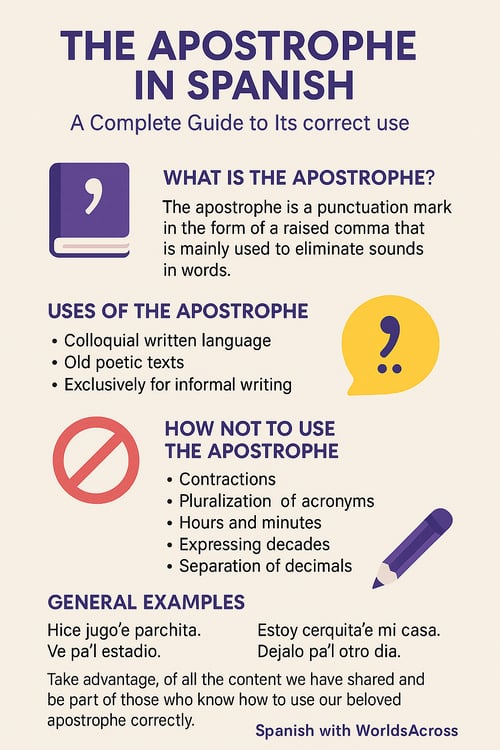The Apostrophe in Spanish: A Complete Guide to Its Correct Use

As a student of Spanish, you should keep in mind that to master this beautiful language, it’s not enough to just speak it. Writing is just as important as conversation. Therefore, learning to use punctuation marks correctly becomes a duty.
When we immerse ourselves in the world of spelling and grammar, we cannot ignore the famous 'apostrophe'. This small raised comma highlights the essence of several Romance languages, and of course, Spanish is no exception. However, understanding its uses can be confusing at first. But don’t worry, that’s why we’re here.
Stay with us! Learn what it is and how to use the apostrophe correctly in Spanish. Let's get started!
What is the apostrophe?
The apostrophe is a punctuation mark in the form of a raised comma that is mainly used to eliminate sounds belonging to one or a set of words. In other words, the use of the apostrophe in Spanish denotes in writing the suppression of sounds in two words pronounced contiguously.
Keep in mind that this punctuation mark should be used exclusively for informal writing and language. The use of the apostrophe in Spanish should not be employed in texts requiring formal or professional writing.

Uses of the apostrophe
Colloquial Written Language
We must highlight that the apostrophe in Spanish is currently not widely used. Even so, the main function of this punctuation mark today is to unite two words by suppressing sounds, for example:
- Vámonos pa’l monte [Vámonos para el monte]
- El perro’e Pedro me mordió [El perro de Pedro me mordió]
- Fui pa’l bosque y me perdí [Fui para el bosque y me perdí]
Old Poetic Texts
The use of the apostrophe in Spanish was much more common in historical texts to denote the exclusion of the last vowel of some words when the next word starts with a vowel. For example:
- "D'alta cumbre en soledad moraba el anciano ermitaño" (from "La Araucana" by Alonso de Ercilla).
- "D'oro fino, d'arco grande y fuerte" (from "El cantar de los cantares" by Gonzalo de Berceo)
- "D'Amor, que en los pensamientos era inmenso" (from "Soneto" by Garcilaso de la Vega)
How Not to Use the Apostrophe in Spanish
If you have ever made mistakes using punctuation marks in Spanish, don’t worry. Mastering these marks can be complicated since most are employed under strict grammatical rules that are not easy to manage.
Very often, the apostrophe in Spanish is used incorrectly. In fact, it’s more common to find writings with errors in the use of this mark than those that use it correctly, even when the authors are native Spanish speakers. Here are some examples of how not to use it:
Contractions
Colloquially, contractions are applied to some words that allow for a natural suppression of their sounds. For the preposition 'para', 'pa' is used. For the noun 'doña', 'ña' is used, and for the word 'nada', 'na' is used.
For these contractions, the use of the apostrophe in Spanish is not considered correct. Observe the following examples:
- Incorrect: Me voy pa’ Toluca.
- Correct: Me voy pa Toluca.
- Incorrect: Estoy con ña’ Carmen.
- Correct: Estoy con ña Carmen.
- Incorrect: No tengo na’ de na’.
- Correct: No tengo na de na.
Pluralization of Acronyms
In Spanish, using this punctuation mark to write plural acronyms is not accepted. Instead of writing: los DVD’s, it should be written: los DVD.
Hours and Minutes
Another common mistake when applying the apostrophe in Spanish is separating hours from minutes. Thus, we can understand that 16’15 h is incorrect, but 16.15 h or 16:15 h is correct.
Expressing Decades
As with the pluralization of acronyms, to express decades, this punctuation mark should be avoided.
- Incorrect: Extraño los 80’s.
- Correct: Extraño los 80.
Separation of Decimals
To separate decimals, it is correct to use a comma. Instead of 2’317, it should be written 2,317.
Expressing Years
To properly abbreviate years, avoid using the apostrophe. Simply expressing the last two digits is sufficient.
- Incorrect: En el año ’94.
- Correct: En el año 94.
General Examples
Now that you know how to use this interesting punctuation mark correctly, it's time to learn some extra examples. Study them and add them to your collection of colloquial phrases with the apostrophe.
- Hice jugo’e parchita.
- Ve pa’l estadio.
- Estoy cerquita’e mi casa.
- Déjalo pa’l otro día.
- Mira al hijo’e Pablo.
In summary, the fact that the use of this punctuation mark has significantly decreased does not mean that it’s not worth learning to use it. Even more so when it has been part of the history of Spanish for such a long time. As you may have noticed, using it incorrectly is quite easy. However, with study and practice, it will only be a matter of time before you master it without any problem.
Take advantage of all the content we have shared and be part of those who know how to use our beloved apostrophe correctly.
See you next time!




